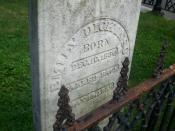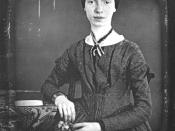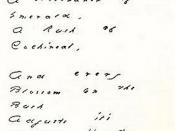Analyzing the poem by discovering how the author used literary elements usually is very essential to understanding the poem's theme. As one of the significant elements, extended metaphor may convey one of key ideas in poetry. Depending on the poem, extended metaphor may provide the opportunity to reflect on even more deep and hidden, but just as important concepts the author chooses to convey. Similarly, in the poem # 371, Emily Dickinson uses extended metaphor as practically the most essential element to convey her feelings in regard to The Antique Book held as fascinating and exciting volume.
Emily Dickinson compares real historical characters to the Antique Book, giving it the qualities of a fine gentleman. It is a "precious pleasure" to meet such a gentleman who will entice with and tell of his radical but thrilling notions. What must mesmerize Emily in the "Antique Book" are realistic images of "the Dress his Century wore," along with the opportunity of learning about compositions by Shakespeare, Sappho, Sophocles, Plato, to inspect their thoughts in detail, and to understand their contradicted ideas- dreams of the future.
Such account of acquaintance, enhanced with the facts of history, is an "Enchantment." This sophisticated "figure" may be dear to the narrator in the same way Beatrice may be to Dante. It is only one of the many reasons why Emily Dickinson would call "Antique Book" a gentleman-like, where the contents of a volume either entice, reflect, intrigue, puzzle, or fascinate the narrator.
The development of this metaphor may be compared with the process of reading and enjoying a book. It can also be seen as an acquaintance with a particular person. As when meeting the "gentlemen," the narrator may acquire strong fascination for this "person." Fascination of Emily Dickinson may be seen through diction, since it...


